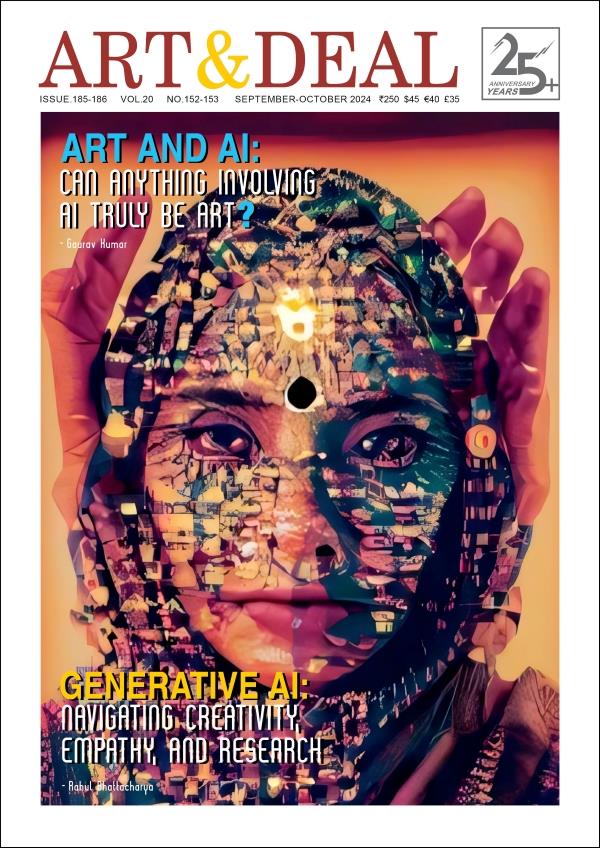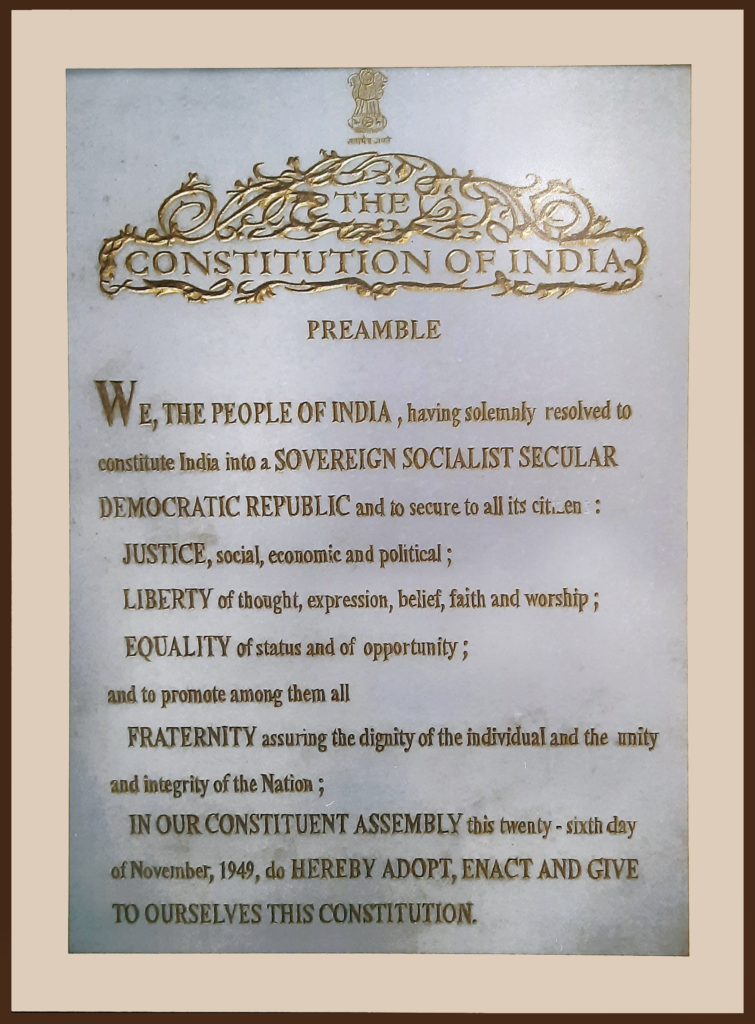
Working in a museum is interesting and nostalgic. The objects displayed in museums often seem mysterious, and we are curious to visit them for the pleasure of learning. A museum is a place for informal learning, and museum objects are believed to be part of a collection from past human history largely not relevant to the present. Going back to the origin of the museum concept, we find the term ‘Cabinet of Curiosities’ or ‘wonder-rooms’ which served as a space for edu-entertainment in modern understanding. In museums, we often encounter visitors’ usual questions like “Is it real?” or “Are they excavated?” They use the term ‘prehistoric’ for most of the museum objects strangely, not considering the ‘time’ factor of any object. Visitors in general focus on and are attracted to the ‘mystery’ factor attached to the objects on display. However, a museum is a place where we also learn about ‘living history’ reflecting the recent past to the present. So, when ‘The Constitution of India’ is on display, it is a living history relating to the recent past, present, and future of Indian citizens. Important people in India said, “The Constitution is like the Bible, Quran, and Bhagavad Gita for us,” which means it is our practising reality.
The Constitution of India was adopted to mark the birth of a new nation. The book assured our democratic rights, making India a democratic republic. In light of the contemporary world order, ‘democracy’ secures dignified life for common citizens while keeping the values of freedom, equality, and inclusivity in society. The age-old concept of democracy can be found in ancient text references talking about involving people in decision-making, but in 1947, the creation of the constitution was a key factor in declaring a country’s independence. Historically, Communist Party leader M.N. Roy demanded the Constituent Assembly in 1934 and was accepted by the British government in 1940, which was later pursued by the Congress. Accordingly, on December 9, 1946, the Constituent Assembly was founded, Sir B.N. Rau developed a framework as the constitutional adviser, and the first draft of India’s new constitution was released to the public on February 26, 1948, on which a total of nearly 500 suggestions for amendments were received.[1] The drafting committee, chaired by Dr. B.R. Ambedkar, started functioning on August 29, 1947. The Assembly held 11 sessions for making the final two copies of the document in 2 years, 11 months, and 18 days. The English version, ‘The Constitution of India’ and ‘Bhartiya Samvidhan’ in Hindi, were adopted on November 26, 1949, to achieve sovereignty, which came into effect on January 26, 1950. The anniversary of the adoption of the constitution is celebrated every year on November 26 as Samvidhan Diwas, or ‘National Law Day’, which is now declared as the ‘Constitution Day’ by the present Government of India on November 19, 2015.

On the occasion of 75 years of India’s independence in August 2021, a digital photo exhibition titled ‘Making of the Constitution’ was initiated as part of ‘Azaadi ka Amrit Mahotsav’, by the Ministry of Information and Broadcasting (MIB), followed by a series of e-photo exhibitions for an entire year focusing on the freedom struggle of India. On November 26, 2023, a photo exhibition of the illustrations created on the pages of the Constitution of India was opened for public viewing, placing ‘The Constitution’ as ‘an object of museum exhibition’ at Ajanta Hall, National Museum, Janpath, New Delhi. The exhibition was important to understand Indian art in the republic, reminding us of the dreams that united us to re-explore the point in time from where we started as an independent country, ‘India that is Bharat’, towards a progressive future in 1947. For the new generation of citizens, the exhibition of the origin story of the Indian Constitution brings the opportunity to know the history of modern India because we hold the world record for having the longest constitution, a timeless masterpiece and said to be thirty times longer than the American Constitution. The launch day was rightly named ‘National Law Day’ because it reflected the idea that ‘The Constitution’ is not just a book to read and display; it is the ‘law of the land’ to protect the rights of citizens.
We need to know a museum’s role in a community and understand the importance of revisiting an object in a museum exhibition to realize the value and context of an exhibit and generate awareness about socio-cultural reality. In the present time, human memory is short and diverted by social media and often misleading digital engagement. Museum exhibitions remind us of forgotten truths, refreshing social memory and helping us to interpret today’s facts beyond traditional roles in preserving historical artefacts and their stories. When any of our belongings is termed a ‘museum object’ then it is musealized. It is a process of transforming ‘things’ into ‘objects on display’ and changing the status without any physical change.[2] We may ask why an object is removed from its real context and placed in a museum exhibition and try to reason, especially when the object on display is the Constitution of India. However, a museum object is authentic material evidence of human history and a source for studying the context. Hence, the museum exhibition of the illustrated pages from the Constitution of India reminds us of our duties and rights for our collective good. In today’s India, the Indian Constitution has been a frequent topic of discussion to realize its meaning in contemporary life. It even faces conflicts and is often criticized as ‘borrowed’ for taking guidelines from other countries during its making. The said exhibition displays rare photos, video sourced from Prasar Bharati Archive, Films Division, large prints of illustrated pages from the Constitution, and two copies of the Constitution showing the content page and the last page with the signatures of the makers. The exhibition highlighted the illustrations, the less-explored artistic angle of India’s supreme law book tracing the journey from the formation of the Constituent Assembly to the adoption of the Constitution, the drafting committee members and artists.

The Constitution of India is a handcrafted, rare piece of art rich in embellishment with calligraphy and illustration, with various symbols representing the nation’s five thousand years of history. It took five years to produce the first two copies of the document, painstakingly handwritten in English and Hindi, which are kept in helium-filled cases in the Library of Parliament. The original books are bound in Morocco leather, embossed with intricate gold patterns on the front and back covers inspired by the Ajanta murals, and each part of the Constitution begins with hand-painted illustrations. The pages of this manuscript, measuring 16×22 inches, are made of 90-100 gsm parchment papers having a lifespan of around a thousand years, sourced from the ‘Handmade Papers Institute’, Pune, which was strongly associated with Swadeshi movements. The principal copy of the Indian constitution was written in Roman script English, and handwritten calligraphy is credited to Prem Behari Narayan Raizada (Saxena), as all pages show his signature ‘PREM’. He completed this calligraphy assignment in six months sitting in the Constitution Hall, which is presently known as the Constitution Club of India. The second copy was in Devanagari Hindi, written by Vasant Krishnan Vaidya. The first two sets were decorated by a team of artists led by the famous painter Nandalal Bose from Shantiniketan.[3]
Raizada the calligrapher, a graduate of St. Stephen’s College, Delhi, acquired the skill of calligraphy writing from his grandfather, Master Ram Prasad Saxena, a calligraphy researcher and scholar of Persian and English who taught Persian to high-ranking officials of the British Government. Prem Behari Raizada was born on December 16, 1901, lost his parents at an early age and lived with his grandfather during childhood, and later he became a famous calligrapher. When Jawaharlal Nehru called him to write the constitution, he went to Shantiniketan with Shri Rajendra Prasad, then president of India, to meet Nandalal Bose for this project to decide about writing and designing spaces on the pages. He wrote 1,17369 words in flowing italic calligraphy using dip ink-pens, totalling 432 nibs of No. 303. The nibs, brought from England and Czechoslovakia, were affixed to a wooden holder and dipped in ink for the writing. Instead of taking any fees for this work, he requested permission to write his name on every page and add his grandfather’s name on the last page which was honoured by Nehru.[4]
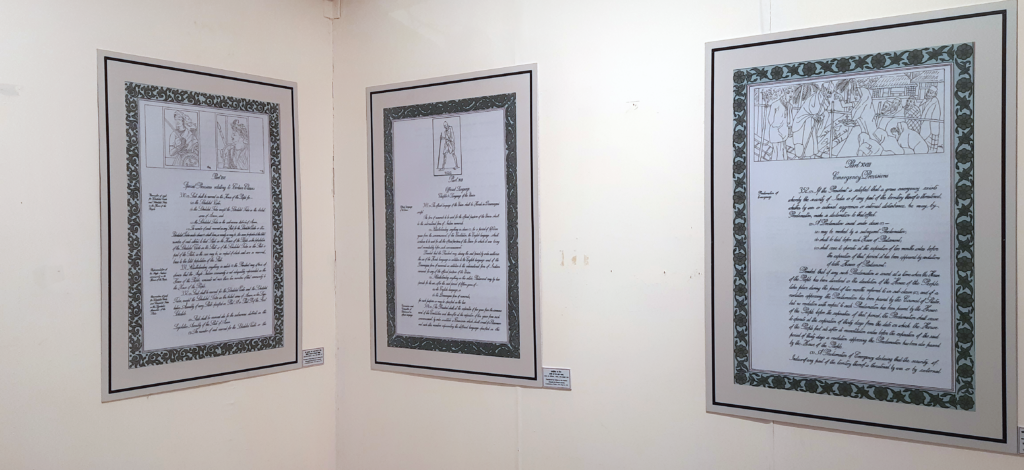
Artist Nandalal Bose decided to select a non-hierarchical team of students and teachers sharing work with the idea of assisting each other when he was invited for the illustration project to decorate the page borders and make theme artworks on the opening pages of each part of the Constitution. His team members included Dinanath Bhargava, Jagdish Mittal, A. Perumal, Kripal Singh Shekhawat, Vinayak Sivram as well as his own three children Biswarup Bose, Gauri Bhanja and Jamuna Sen, with others from Kala Bhavan, Shantiniketan, who designed borders and twenty-two images on the manuscript by hand. The Constitution Hall was the venue for the artists to work together, where calligraphy writing was also in progress. They created the final document which had a preamble, eight schedules with 395 articles that weighed 3.75 kg having 251 pages. The line drawings of illustrations were created using earth colours finished with gold. A few pages, including the Preamble Page, were designed by Beohar Rammanohar Sinha and signed by him as ‘Ram’ or ‘Rammanohar’ and other pages, especially those with a gold touch, created by Nandalal were signed by him as ‘Nanda’. The National Emblem was sketched by Dinanath Bhargava, who was only 21. In the course of work-in-progress, Nandalal was keen to include the Lion Capital of Ashoka on the opening page of the manuscript with a realistic depiction of the lions and chose Bhargava for the drawing because he studied the behaviour of the lions at Calcutta Zoo. Bhargava was asked to create a two-dimensional drawing from a three-dimensional sculpture, the Lion Capital, adding the motto ‘Satyameva Jayate’ (Truth alone triumphs), extracted from Mundaka Upanishad. On the first page, he made a full-page illustration of the iconic Lion capital, surrounded by intricate borders on all four sides consisting of foliage and lotus flowers in the upper and lower panels. Next, the preamble page has text in the centre and four sides bordered with floral designs showing animal motifs at four corners that reflect the Persian style.
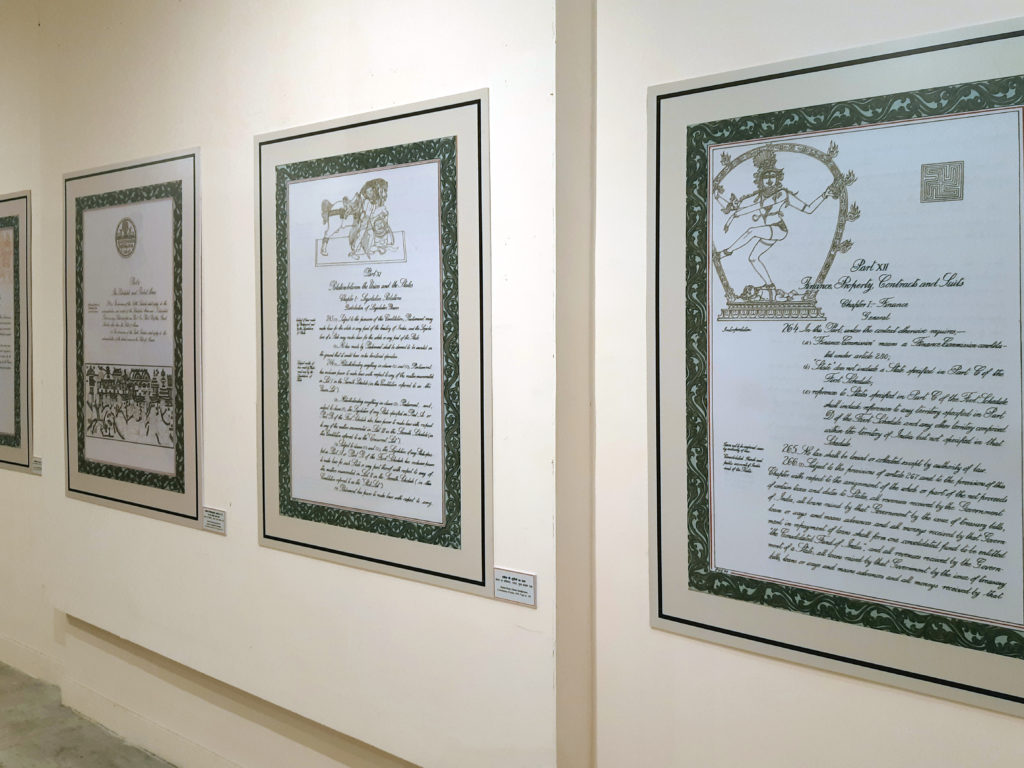
Nandalal placed the illustration of the Harappan Bull seal along with a few letters from the Indus Valley script, symbolizing the beginning, on the opening of Part I. on the next few pages until part two, the text continues within framed margin decoration. Margins are a significant component of this manuscript. We find at least ten variations of margin design in the first edition of the Constitution. Geometric patterns, chains, flora-fauna, or simple lines are often seen with repetitive peacock motifs similar to Mughal and Rajput miniatures. Art historians like B.N. Goswamy write that margins serve as a design element with functionality, demarcating the content or an image. Interestingly, we see many lotus motifs since it is a common symbol in Hinduism, Buddhism, and Jainism. The lotus may also be symbolic of a nation rising. Part II is on citizenship, which is represented by the illustration of the Vedic hermitage. Part III is about Fundamental Rights, which has an illustration of Rama, Lakshman, and Sita. Part IV on State Policy shows the conversation between Arjun and Krishna before the war.
The artworks depicted the eras from the Indus Civilization, the Vedic Period, the Epic Period covering Ramayana and Mahabharata, Mahajanapada, Mahavira, and Buddha; the Mauryan Period; the Gupta Period; the Medieval Period portraying Akbar, Shivaji, and Guru Gobind Singh; the British Period showing Rani Lakshmi Bai and Tipu Sultan; followed by selected events from the Indian Freedom Movement, including Gandhi and Subhas Chandra. Illustrations are based on history and mythology commonly found in any popular book on India. As Nehru himself asked Nandalal Bose to take up this task, it is possible that it was GV Mavalankar’s idea, who was the Speaker of the first Lok Sabha in 1952 and was the driving force behind commissioning the murals and statues for decorating the Parliament building. However, it would be a great mistake to find political meanings in the artworks because we cannot establish whose idea it was to create an illustrated Constitution for India. The exhibition at the National Museum opened an opportunity for viewers to find relationships between texts and images. We may analyze why the illustrated constitution was not popularized much after its completion. Is it just a decorative artefact as a keepsake because ‘art has played a significant role during the independence movements’? Dehradun-based Survey of India, Northern Printing Group printed only 1,000 photolithographic reproductions of the handcrafted Constitution after it was completed. Few have been placed at international auctions for collectors as rare artefacts.
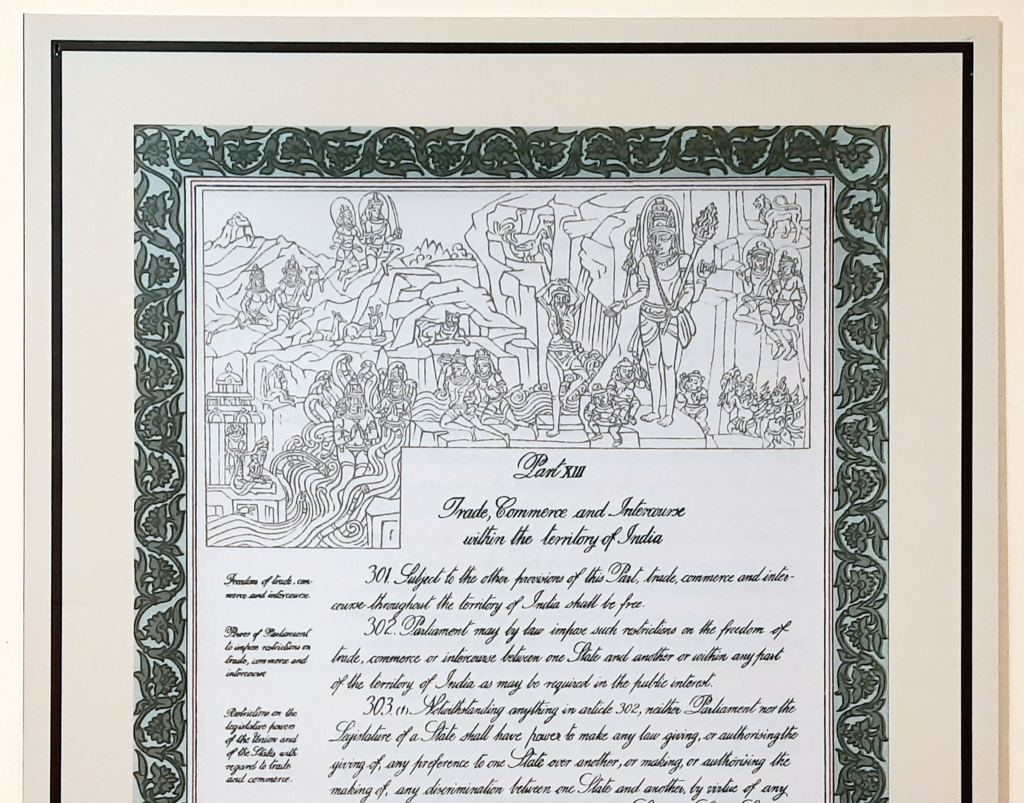
If we look back at the story of making the Constitution, it does not seem that this document was meant to be treated as an artefact to display. The curator’s note claims, “The exhibition attempts to highlight the facts related to the Indian Constitution, its association with Indian art, and the ideologies of the illustrations done on its pages.” When we say, ‘ideologies of the illustrations’, it is thought-provoking and conflicting because India was born with the promise of ‘unity in diversity’. Moreover, creativity cannot be fully defined as ideology. Claiming cultural superiority by referring to the illustrations of the Constitution has been a new trend in recent years. But reading the images and reading the text are two different things. Although interpretation may vary as time changes, changing the fundamental definition can bring challenges. If we examine thoroughly, we find Nandalal Bose’s creative work is not exactly the interpretation of Dr. B.R. Ambedkar’s concept of the Constitution. So we need to see the meaning of images according to the chapters of the Constitution knowledgeably, unintentionally, and responsibly. Bose created a painted historiography, while the text was to give guidelines for citizens to practice in the present and future. The images offer only a chronological assortment of historical events, myths, and popular beliefs without making any statement to commemorate the idea of ‘Unity in Diversity’. The exhibition description also says, “The Indian Constitution makes it clear that preservation of art and culture is a fundamental duty of all Indians,” overlooking the cultural anxieties of all interest groups living in India. Many scholars and art historians raised the point that reading the images too much would be problematic for India. The illustrations are decorative elements only for illuminating the text following the Indian miniature style; they are not visual representations of the texts. The artist-team of Indian origin took references from popular stories from Indian history and mythology to relate to the themes of the chapters without any hidden meaning.
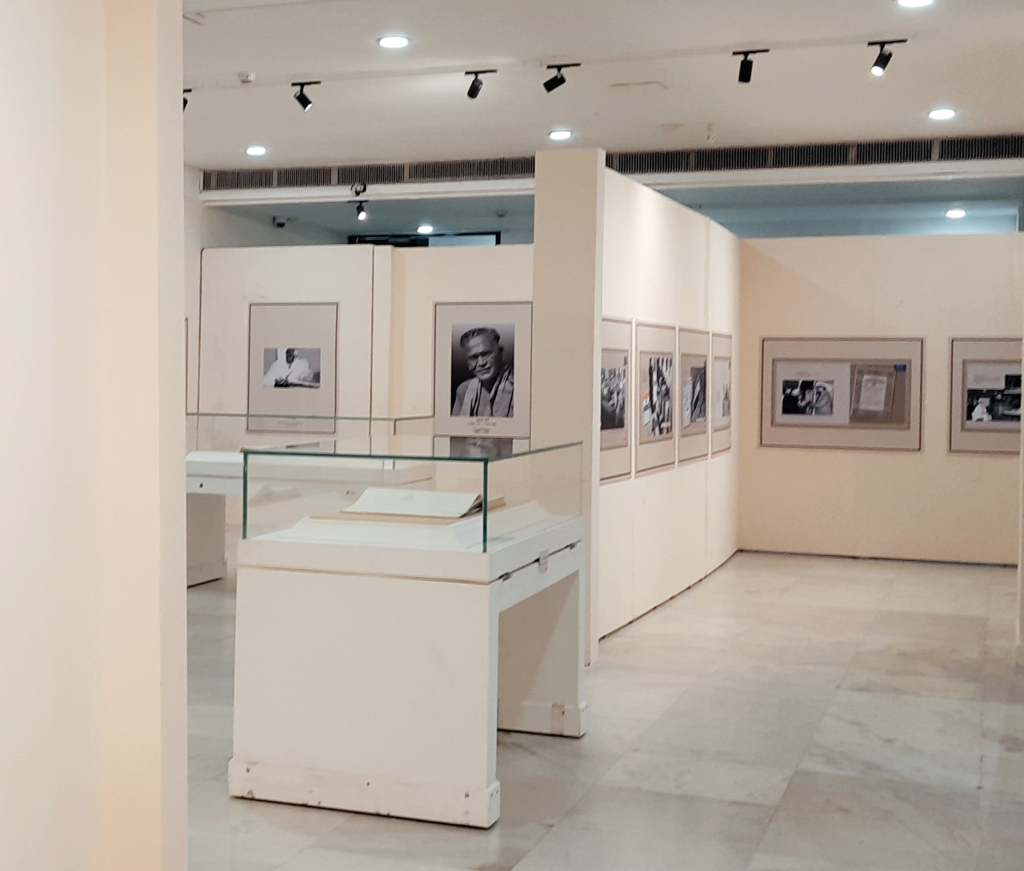
Read More>> Please Subscribe our Physical MagazineBibliography
-Austin Granville,The Indian Constitution: Cornerstone of a Nation,Oxford University Press, 1999
-Ghosh Debabrata, Masterstroke: Vol. 1, Notion Press, 2022
-Mairesse, François Editor, Dictionary of Museology, Routledge, London 2023
-Rao B. Shiva, The Framing of India’s Constitution: Select Documents, Volume 2, Indian Institute of Public Administration, 1966
-Rau, Benegal, Narsinga, India’s Constitution in the making, Bombay; New York: Allied Publishers, 1963
-Sen Gupta Subhadra, The Constitution of India for Children, Penguin Random House India Private Limited, 2020
-Sapru Tej Bahadur, The Indian Constitution, National Secretary’s Office, 1929
-https://www.constitutionofindia.net/stages-of-constitution-making/

